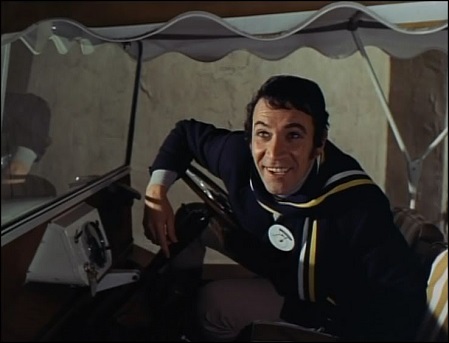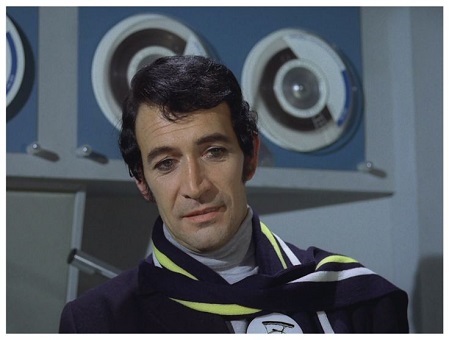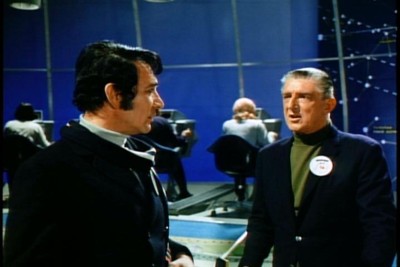Observations on Peter Wyngarde in the Prisoner episode, ‘Checkmate’

In asking 1960’s viewers to think seriously about the world around them, and about authority in particular, Patrick MaGoohan presented us with the various forms of that authority in the various models of Number 2 – the omnipresent overseer in the mysterious twilight world that was “The Village”. Whether it was the coldly efficient Guy Doleman in ‘Arrival’, the reliable and trusted Leo McKern in ‘The Chimes of Big Ben’ and ‘One Upon A Time’; the nervous Colin Gordon in ‘A.B. & C’, or the paranoiac and unbalanced Patrick Cargill in ‘Hammer Into Anvil’, the series presented these feudal lords in such guises ranging from the outright callous to the (ostensibly) benevolent.
Peter Wyngarde’s Number 2, however, presented us with a very different face, From the opening voice-over exchange with McGoohan’s Number 6, we hear that this Number 2 is new; his responses to the snappily barked tones of his prize captive are distinctive. Neither hotly emotive nor coldly flat – these tones are modulated; balanced. Even the classic “We want information. Information! Information!” scarcely rises in its crescendo. Yet we get a subtle hint of underlying menace in the considerable gap that the actor leaves between: “By hook or by crook,” and “We will!” – adding great emphasis to the latter half of the phrase.
Writer, Gerald Kelsy, takes the game of chess and uses it for a multi-layered metaphor on life, both within and outside ‘The Village’. He takes the confined environment of 64 black and white squares and uses it to examine the relationship of the pieces within the equally confined, yet picturesque, prison.
Of course, looking down on all this from a distance is the player – the man who, in isolation, holds the power to affect both his own pieces moves and the respective moves of the opposition. Peter Wyngarde is, essentially, this player – despite the fact that he has relatively little screen time and often seems removed from the fray. Much of the episode is left to Number 6, who is somewhat under the impression that HE is in fact the player of the game, and that his plans to discover who are genuine prisoners and how to use them to aid his escape.
Unlike previous Number 2’s within ‘The Village’, Peter’s chief administrator is prepared – in many aspects – to allow Number 6 the full length of his leash. Like any good chess player, he seems to be taking the overview and appears to be thinking at least two or three moves ahead. Notice Peter’s earliest scenes in the Surveillance Room with Basil Dignam’s Observer. Number 2 takes, at first, a somewhat casual view of Number 6’s activities; “Well, he seems alright to me”, but immediately after tells the Observer not to let himself be fooled. Most importantly though, it is the Observer who says that he will keep Number 6 under close watch; Peter appears to take the casual outlook still.
The detachment is further observed in Number 2’s treatment of the rouge Rook. Despite alarms going off and loudspeaker announcements everywhere, Peter’s subdued reaction is simply to call the Rook into hospital for treatment; no panic. Wearing his old college scarf and with his “Hail-fellow well-met” greeting to Number 6 before taking him to see the Rook, Number 2’s attitude is that of an old friend meeting an old friend. However, al chilling scene takes place within the hospital’s Observation Room.

Peter’s attitude to the Pavlovian treatment of the Rook is as cold and scientific as that of Patricia Jessel’s unfeeling doctor. Throughout the scene he maintains a steady gaze upon the poor Rook – a look which is interested, yet unaffected by the rebels trauma at his shock treatment. It’s clear that this Number 2 values society as it exists within The Village above all else. His ultimate aim seems to be conformity by all. Side by side, Number 2 and the Doctor are easily more menacing than Lady Macbeth and her driven spouse were – and yet no direct threat is uttered by either.
When he learns that Number 6 is becoming involved with the reintegrated Rook, Number 2 declines close observation of the pair after consulting with the Doctor about the Rooks enforced social rehabilitation. He puts his faith in both science and the society which science has created. Again, this Number 2 remains aloof and is still prepared to let the game play itself out. His faith in science is further enhanced when he brings the now suspect Number 6 in for scientific analysis and evaluation.
Cold detachment really comes to the fore in Number 2’s and the Doctors treatment of Roselie Crutchley’s ‘Queen’. Now Number 2 is prepared to use basic human emotion to his own ends – by hypnosis, they persuade The Queen that she is in love with Number 6, and he with her – so much so that he’s given her a locket. Contained within the jewelry is a transistorised device which monitors her pulse. By this method they will be able to gauge if Number 6 is in the vicinity.
Again, Number 2 is taking a chance playing the game at long distance. Despite the fact that he has many good visual sources within The Village at his disposal, he trusts to his method. He also demonstrates a deeply hidden callousness in playing with this particular emotion in this way – thinking not of the consequences to The Queen.
In spite of the fact that Number 6 steals a Minimoke, Peter’s character remains cool and tells the observer not to act unless he gets a formal alert. Thus the game continues and Number 6 begins to realise his escape plan. Some time elapses before Number 2 is seen again, this time talking to The Rook on the beach – but even here his bonhomie is littered with scientific psychological terminology.

Meanwhile, Number 6 discovers the locket and takes it from The Queen. The Observer and the Doctor begin to panic until they’re able to get Number 6 within the camera’s eye.
In their next move, Number 6 and his small band of potential escapees transmit a false radio Mayday in the hope of being rescued from outside. When alerted, Number 2 is unmoved by this, prepared to leave a responding ship to it. The Observer undertakes a radar search and realises that the radio source is close to The Village, so he orders a searchlight sweep. Number 6 knocks out the dangerous light and the Observer is forced to call Number 2.
Finally we see another face of Number 2 – he is in the Control Room dressed in Oriental robes and is in a posture of meditation. Only now does he appear flustered – his private moment of concentration has been broken. His reaction to this disturbance is to Karate chop, and break, a piece of wood which has lain before him throughout. Martial Arts – another aspect of controlled activity; of channelled emotion.
By the time Number 6 and his crew storm the Green Dome, Number 2 is dressed and ready to greet them, in a calm and friendly manner; he doesn’t even object to being tied up! The Prisoner makes good his escape and arrives on the boat, MS Polotska. But no sooner is he on-board than the television monitor flickers into life. There, again from a distance, is Number 2 – observing and commenting on the situation. The camera pulls back to reveal the whole picture – with him is The Rook, and on his console is a single chess piece: a pawn.
The game is played out. Number 2 observes that the basic flaw in 6’s plan was his own strategy – in contriving to use his own psychological test to determine who were the ‘Prisoners’ and who were the ‘Warders’, Number 6 failed to see that his strategy could work against him as we as for him. Thus The Rook had taken Number 6 for a Warder and the whole escape plan for a trap. As Number 2 coolly puts it: “There has been a slight misunderstanding”, and he points to the fact that the Polotska is a Village vessel.
Number 6 smashed the TV and attempts to escape. Only now does Number 2 sound an official alert – even this is done characteristically; without any fuss whatsoever, he presses a button on his console to activate Rover – the Village ‘Guardian’. As the action concludes, Number 2 can be seen gently strumming his fingers in the background – waiting. The game’s symbolism ends as Number 6 is returned to The Village and the dwarf butler replaces the pawn from the console onto the main chessboard. It was the only piece out of place…
Conclusion

‘Checkmate’ is one of the definitive Prisoner episodes, not only for its extensive use of the Portmeirion locations and the now classic game itself. Like a good game of chess, ‘Checkmate’ is a spirited progression, complete with sacrifices, move and counter-move, until we reach an end, which can be one of only two things – the destruction of the king or stalemate. On the surface there is such a stalemate. Number 2 has not broken Number 6, but then neither has Number 6 escaped his prison. Neither man has achieved his outward goal. However, I would suggest that this is the one episode in the series in which The Village has a clear victory.
In his isolation, Number 6 has just one thing he can rely upon – himself. His own mind. His independent, individualistic psyche. Yet here, in this battle of wills – in this game – he has clearly been defeated. Not by any simple action or reaction by his opponent, but by himself. He was his own worst enemy.
It is to the credit of Peter Wyngarde and his director, the late Don Chaffey, that this Number 2 came out so well. The Village chief is played almost exactly as a mirror image of Number 6 himself – cool, calm and collected – but clearly aware of every other strategy on the table.
Jason King may’ve been cool, but even HE might shiver if he met THIS mysterious Number 2!
Written by Al Samujh
More About ‘Checkmate’
© Copyright The Hellfire Club: The OFFICIAL PETER WYNGARDE Appreciation Society: https://www.facebook.com/groups/813997125389790/

